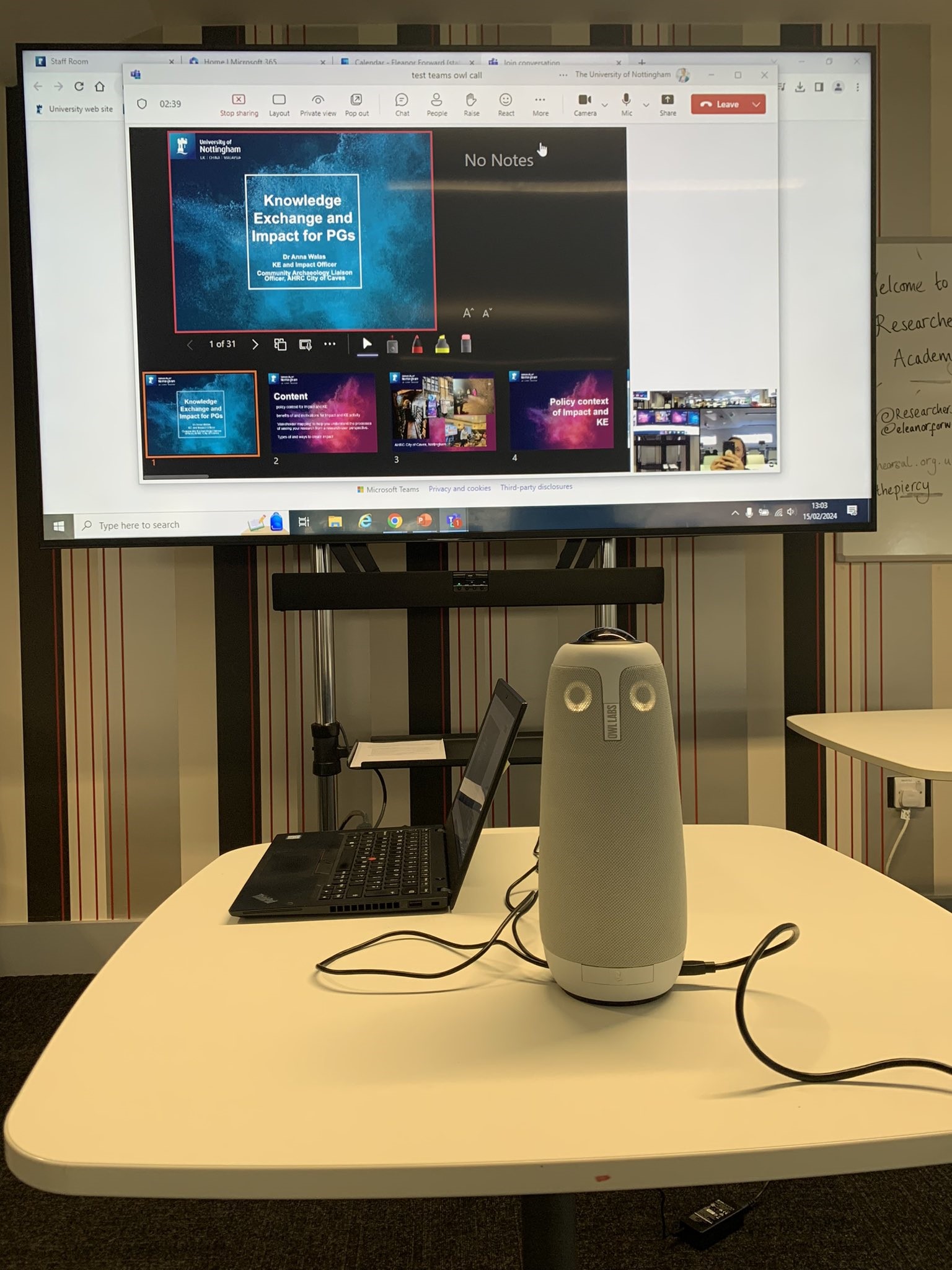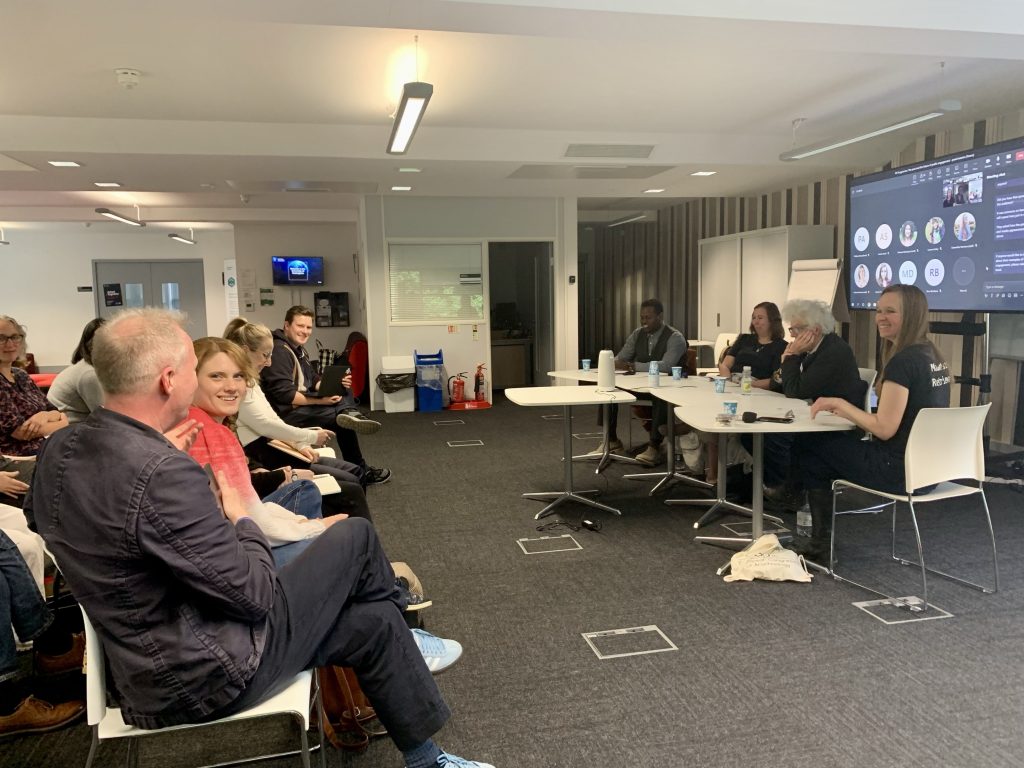
June 21, 2024, by Laura Nicholson
Hybrid sessions with the OWL camera
Throughout the 2023–4 academic year, we are running a new feature on the Learning Technology (LT) blog: a faculty takeover month! Each month, we will feature posts from different faculty members at the university. Every Friday, posts will highlight interesting work and ideas related to technology in teaching and learning and showcase unique projects from within the various disciplines across the UoN. So far, we’ve featured content from all the faculties at the University and the degree apprenticeship programmes at UoN. This month, we welcome posts from the Researcher Academy.
In this post, Barrie Edmonds, Learning Technology Consultant for Research and Innovations is joined by Eleanor Forward of the Researcher Development Team at the Researcher Academy, who shares her experience of using a conference camera for hybrid sessions delivered as part of the Faculty Programme for Arts researchers.
The purpose of these sessions was to bring together Arts researchers and advance their learning through talks from expert tutors, Q&As, and group discussions with peers and tutors on topics such as Knowledge Exchange and Impact, Time to Write and Preparing for the viva.
Running these sessions in a hybrid format allows for flexibility and accessibility for attendees, as some Arts researchers aren’t on campus regularly and/or live outside Nottingham.
Can you describe the situation prior to using the new camera?
I had been tentatively running a couple of sessions on the Arts Programme in hybrid format using a laptop, webcam and MS Teams. You could say I was muddling through and trying to make the best with what I had but there were issues with feedback when co-tutors joined via Teams, and during Q&As. The experience wasn’t as good as I knew it could be. There was a disconnect between those on-campus and those joining online. If someone near the back of the room asked a question, I had to repeat it for those joining us via Teams, so it was clunky. In-person presenters also had to stay in one place, in shot of the camera, otherwise those joining online couldn’t see/hear them. Also, a tutor would need to be constantly monitoring the chat function in Teams to ensure written comments were not missed.
How does the new camera change the experience?
We bought the OWL Meeting 3 camera – an intelligent camera that pans and tracks speakers across the room. The OWL requires a little more setup than a normal webcam, as it comes with its own power supply and an optional extension microphone. However, once connected to your laptop, you can simply select it from the list of audio and video devices from your MS Teams meeting when starting the call.
It offers a more joined-up, dynamic and interactive experience for all attendees. The OWL splits the screen into speakers and then a panoramic shot of the room, so researchers joining via Teams can see everyone—it makes them feel more connected to the session. The OWL is also able to identify/isolate those speaking, highlighting them visually and with clearer audio. This helps immensely when having class discussions or Q&As. We have the mic expansion pack too, which helps with bigger rooms, as even those sitting at the back can be heard. I also think it makes me feel more confident – as a tutor – in running hybrid sessions.

The students are able to see the Teams participants on the screen in front of them and the OWL is placed on the table to capture discussions from speakers in the room
I think it makes the sessions more fluid and connects the in-person and Teams researchers more effectively, so whereas previously they’d preface their questions or comments with, “Will everyone be able to hear me?” or feel the need to stand/move closer, or perhaps it discouraged them from speaking at all, now they’re more fluid and natural with the way they communicate across the in-person/Teams interface.
It’s taken a few goes to get used to the set up with the OWL, where to situate the various parts, extension mic, etc. Meetings have been more straight-forward than workshops but I learn something each time I use it – and with a couple of colleagues using it too, it’s useful to compare/contrast set-up and experiences. Last month, one of my colleagues suggested mounting the OWL on a tripod, which helps it find or isolate speakers who are sitting down.
I’m still tweaking the set-up/approach each time too, with their support and feedback, eg working out where best to position the extension mic and having an extra laptop/using my phone to connect to Teams, so I can monitor the chat and type without the OWL picking me up mistakenly and highlighting me on the screen when I’m not presenting!
Have you had any specific feedback about the OWL?
As mentioned above, participants have been more engaged and confident in their engagement during sessions. Feedback has been positive from both in-person and Teams attendees—perhaps moreso with the latter group, as it makes for a smoother, more audible and more interactive session for them. As part of the recent Arts Programme evaluation with Arts PGRs. I invited feedback on the hybrid/OWL experience and researchers commented that it was “much better” (than without the OWL), “I could hear the speakers more clearly,” and “I felt more included in the session […] and better connected to the other students.” In addition, colleagues have been very interested in the new technology and the lessons I have learned from running hybrid sessions.
No comments yet, fill out a comment to be the first

Leave a Reply